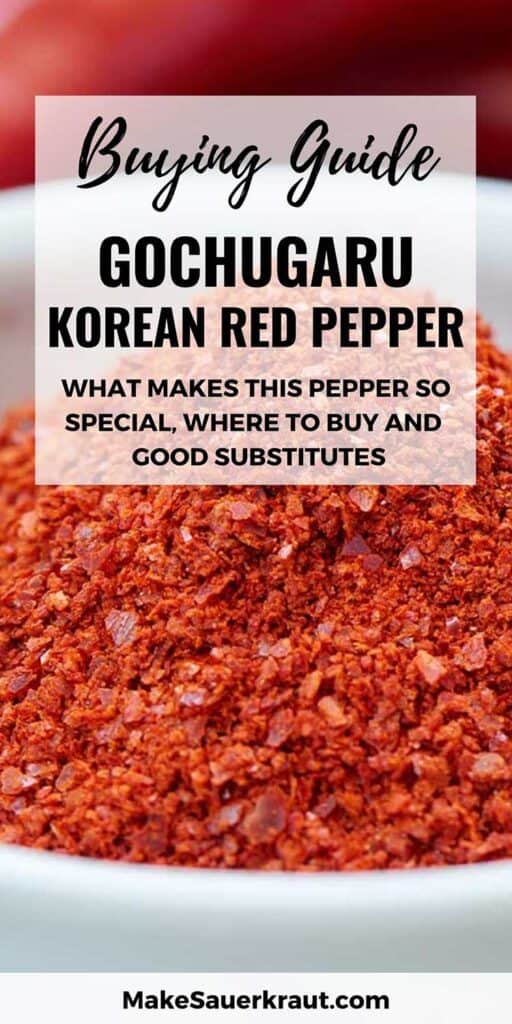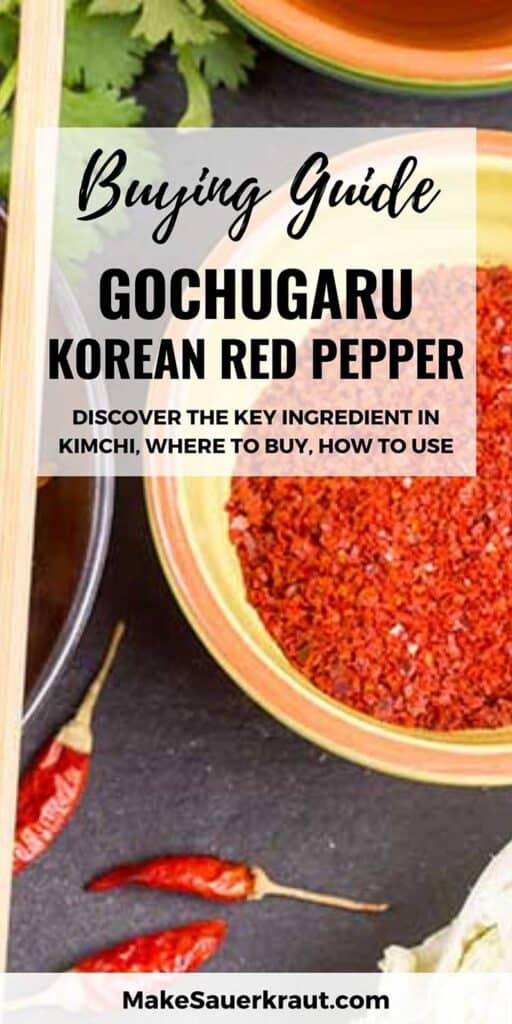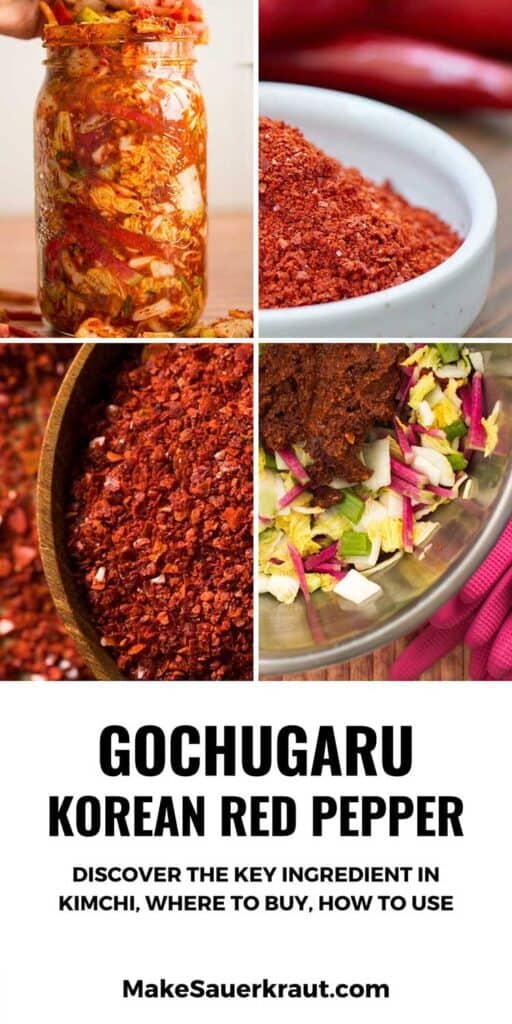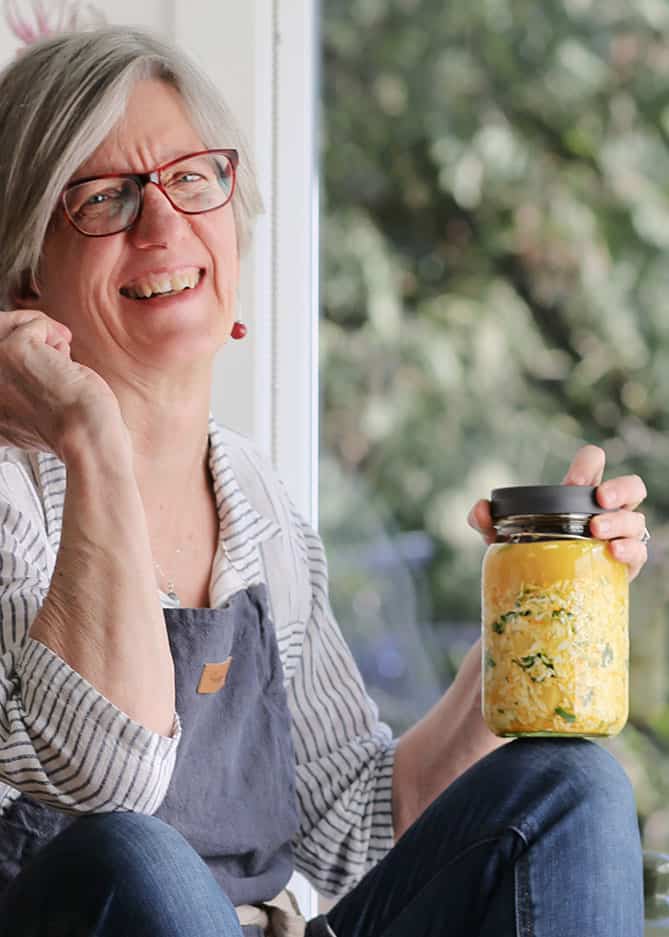Get ready for incredible flavors not only in your homemade kimchi but in any dish calling for red pepper flakes or chili powder. When I delved deep into learning how to make traditional kimchi, I unearthed the secret ingredient that gives kimchi its signature heat, color, and flavor: Korean red chili powder, or gochugaru. Discover what makes Korean red chili powder so special, how to buy it, use it, and suggested substitutions.
- What is Gochugaru (Korean Red Chili Powder)?
- Shopping Guide for Korean Chili Powder (Gochugaru)
- Recipes that use Gochugaru Korean Red Pepper Powder
What is Gochugaru (Korean Red Chili Powder)?
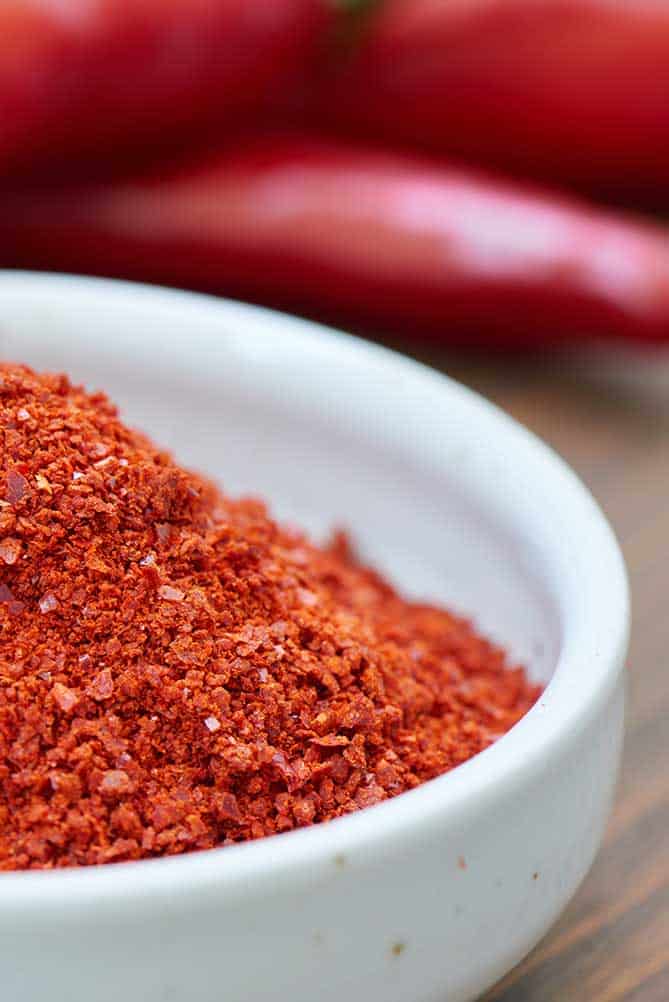
Gochugaru (GO-choo-GAH-roo), also known as Korean chili powder, is a staple ingredient in Korean cooking. The name “gochugaru” is derived from Korean gochu-garu (고춧가루; gochutgaru), where gochu (고추) means “chili pepper” and garu (가루) means “powder”.
Gochugaru is a vibrant red color with a complex flavor that is a wee bit spicy, sweet, and slightly smoky. The actual spiciness can vary depending on the region of origin and its specific farming conditions.
You will see gochugaru referred by a variety of names:
Korean red chili powder, Korean chili flakes, Korean gochugaru, hot pepper flakes, gochugaru pepper, red pepper flakes, kimchi powder, red pepper powder, etc.
You have to visually inspect the contents to make sure that you are buying the traditional spice that is used to make kimchi.
Read on for what to look for.
There are Two Types (Textures) of Korean Chili Powder
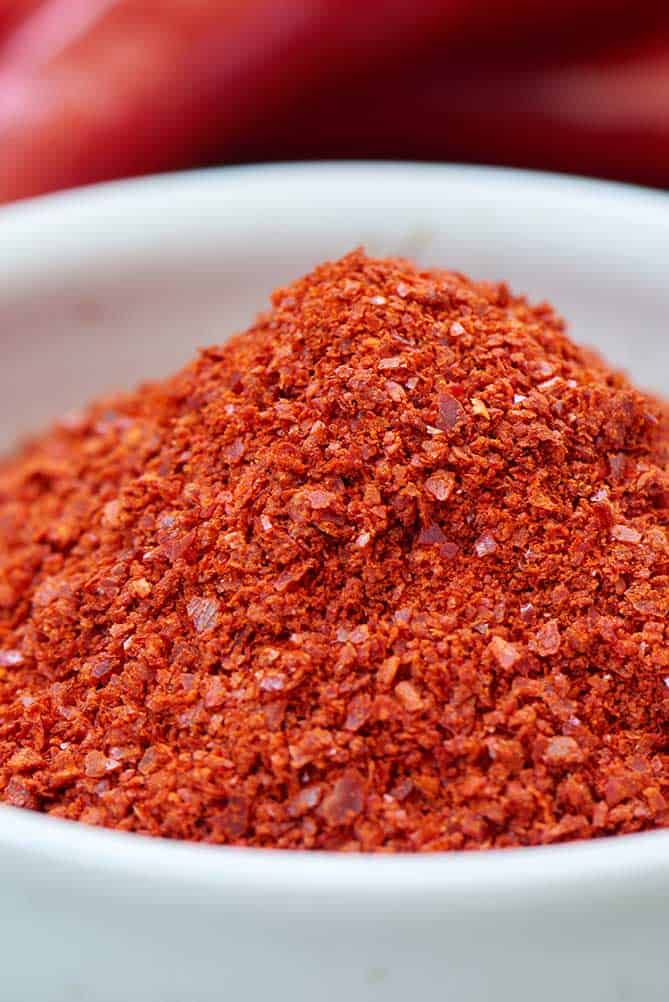
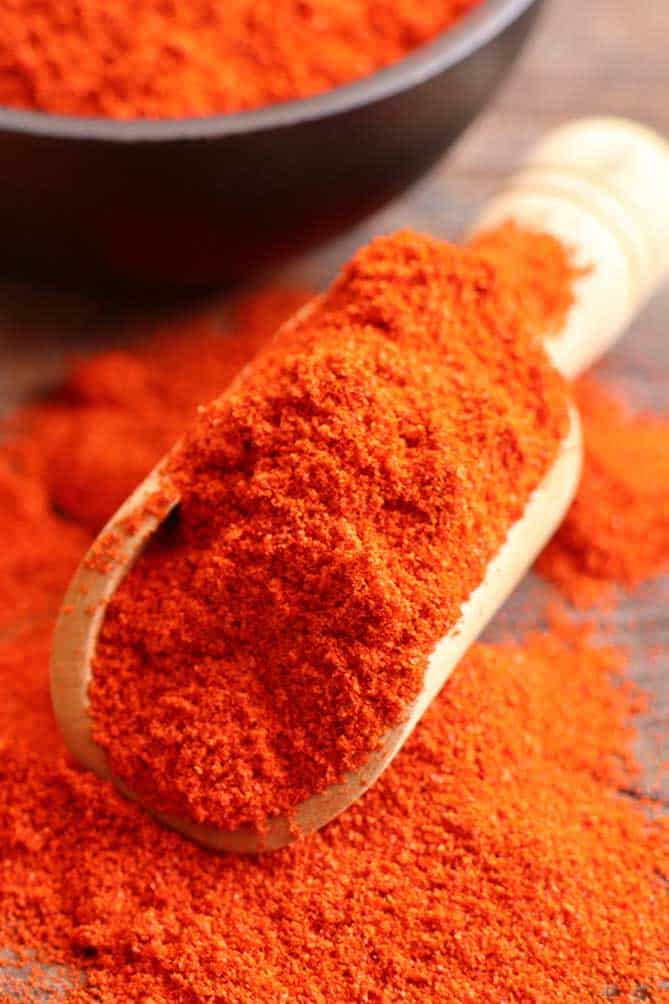
There are two types, or textures, of gochugaru that Koreans use: flakes (or coarse grind) and fine powder. This can be confusing because both packages might say “powder” on them.
Coarse chili powder (flakes) is used to make the seasoning paste for kimchi. The flakes are blended along with ginger, garlic, and Korean fish sauce to create an important flavor profile that is hard to replicate with other types of chili powders. Many Korean side dishes, soups, and stews are also seasoned with the flakes.
Fine chili powder is used to make gochujang, a Korean sauce, fermented in clay pots, and used much like American ketchup.
Gochugaru Compared to Other Red Pepper Flakes and Powders
Here’s a look at gochugaru next to other types of red pepper seasonings that you may already be familiar with.
Gochugaru is not quite as coarse as the red pepper flakes you would find at your local pizza parlor, nor are they as fine as cayenne pepper. Don’t confuse its flaky texture for actual seeds as is seen in red pepper flakes. There are no seeds in gochugaru.
Red pepper flakes are hotter than gochugaru. In a one-quart batch of kimchi, just ½ to 1 teaspoon (5 ml) or red pepper flakes give plenty of heat. However, when using gochugaru, ¼ cup (60 ml) imparts an incredible flavor profile without overpowering heat.
Chili powder and cayenne pepper vary in heat depending upon what type of pepper was used.
Red pepper powder commonly found in grocery stores is made from a different pepper that won’t have the same flavor profile as Korean red pepper powder.
The beautiful, orange-red hue of kimchi comes from gochugaru. If you are wanting to make the best-tasting batch of kimchi, purchase authentic Korean red chili powder. I originally used red pepper flakes in my Kimchi-Style Sauerkraut recipe but now recommend the real stuff: gochugaru. In the shopping guide below, I share tips and links.
Where does gochugaru sit on the scoville scale?
Korean red pepper powder—gochugaru—is not super spicy. Much hotter are the peppers used in Thai or Vietnamese cooking or the varieties of peppers used in Mexican dishes.
Heat Index for Gochugaru
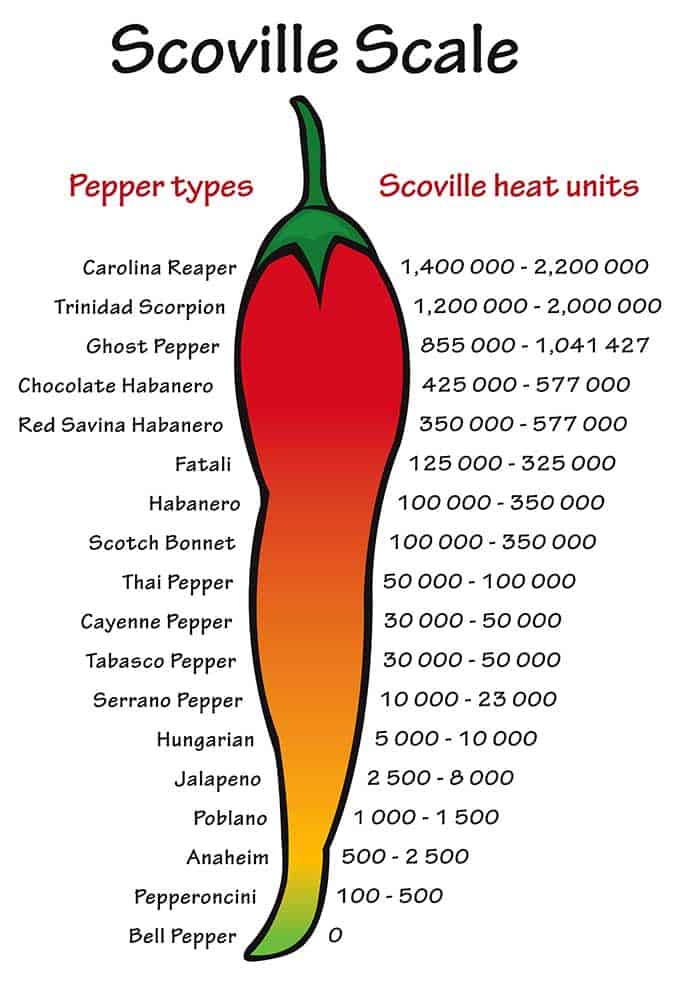
Where do you think Korean red peppers are on the Scoville heat scale?
To know how hot a pepper is, we need to look at Scoville heat units.
Scoville heat units – often shortened to just SHU – are simply a measurement of sugar-water. The Scoville Organoleptic Test measures chili heat by figuring out how much sugar-water is needed to be diluted into a chili pepper mash to get to the point where you no longer feel the heat at all.
—PepperScale
So, if you end up with a batch of kimchi that is too hot for your palate, add some sugar to it to bring down the heat.
According to the PepperScale website, Gochugaru lands In the medium-heat index of 4,000 – 8,000 Scoville heat units, similar to the jalapeño’s 2,500 to 8,000 Scoville heat units. Wikipedia puts green, unripe Korean chili peppers at 1,500 Scoville heat units. I certainly don’t find gochugaru to be as hot a jalapeño pepper.
My Kimchi-Style Sauerkraut recipe calls for red pepper flakes. They have a lot more heat because of the seeds, which are where much of a pepper’s heat is held. It is typically made from cayenne pepper and ranges from 30,000 to 50,000 Scoville heat units. Gochugaru, comparatively, is seedless when made and lower on the heat scale.
To me, gochugaru is not hot – and I don’t like hot and spicy. I have used both the Mother-in-Law's and the Crazy Korean Cooking's brands of gochugaru. I find that gochugaru imparts a long, gentle warmth to foods and does not deliver a quick, spicy hit.
What is the Difference between Gochujang and Gochugaru?
Gochujang is a popular Korean condiment, aka the ketchup of Korea! “Gochu” means chile and “Jang,” fermented. The powder style of gochugaru is used to make gochujang. It’s easy to mix up these two terms.
To make gochujang, soybeans, red chili pepper powder (powdered gochujang), rice flour, malt syrup, and salt are mixed and left to ferment in an onggi pot (a Korean clay fermentation vessel) for 3 months or longer. On sunny days, the lid is removed to allow light to shine on the fermenting mixture.
To make kimchi, a paste is made using the flake style of gochugaru. The flakes are blended with ginger and garlic and then mixed with napa cabbage.
Can I use gochujang paste to make kimchi?
If you can find a brand of gochujang that is traditionally fermented with traditional ingredients such as this list from Mother-in-Law's Gochujang: chile pepper flakes, malt syrup, wheat flour, sweet rice powder, garlic, onion, salt, soybean flour, it would make a good substitution.
How is Gochugaru Made?
Gochugaru is made by drying Korean red chili peppers in the sun, de-seeding them, and crushing them into flakes. “Taeyangcho,” or peppers that have been sun-dried, are considered to make the highest quality gochugaru. Lower-quality brands use peppers that are machine dried.
In Korean, the chili peppers are most often called gochu (고추), which means “chili pepper.” The gochu peppers have a thick wall like a pimento or paprika type pepper and help to slightly thicken the red pepper paste in kimchi as well as give it that crazy cool red color. Gochu peppers are vibrant red and 4-6 inches in length. The dried peppers seen in the video above look bigger than most of the references I’ve come across.
Growing Korean Red Peppers to Make Your Own Gochugaru
If you have a garden and are unable to buy gochugaru, consider growing Korean red peppers to make DIY gochugaru powder or flakes.
This article by Kirsten Shockey, will get you started on the process and help your find the correct pepper seeds (Sherwood Seeds) to grow the right peppers.
Shopping Guide for Korean Chili Powder (Gochugaru)
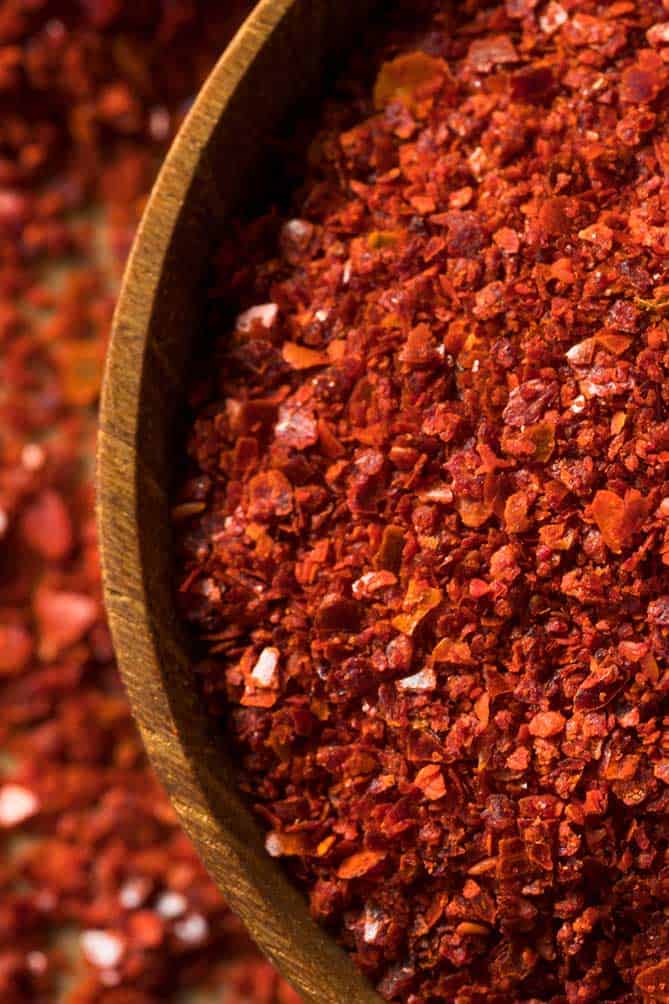
Gochugaru is available both online and at Asian markets or upscale grocery stores. Recommend brands available on Amazon are listed below.
Here’s what to look for to find the best gochugaru or Korean red pepper:
- Look for vibrant red coarse pepper flakes that have been naturally sun-dried. Brownish-red color indicates oxidation.
- For the best quality, select a brand that has been naturally sun-dried (you might see “taekyung” or “taeyangcho” on the label) and has only red pepper as an ingredient.
- Many packages will be labeled “powder” even though what is in the package are flakes. Look carefully at its texture to ensure you are purchasing the right kind.
- Check the label to verify that only one item, “red pepper,” is listed.
- Bypass listings for gochujang which is Korean red pepper paste.
- Organic gochugaru? Best to buy organic, if possible. Peppers are now listed on EWG’s Dirty Dozen.
The label “red pepper powder” is on both of these packages. The one on the left is flakes and the one on the right is powder.
On some packages, you may find different heat indicators for the gochugaru. According to Maangchi at her website of authentic Korean recipes:
The spice level of these hot pepper flakes varies from mild to hot. I use less spicy flakes in many recipes, which allows me to use more and make the dish redder!
When buying these flakes, “maewoon gochugaru” means very hot spicy hot pepper flakes and “deolmaewoon gochugaru” means milder.
Try to buy the ones that are made with sun-dried peppers, which will be labeled as 태양초 on the package.
My Favorite Gochugaru Brands Found Online
I always have one of these brands of Korean red pepper flakes stockpiled in my freezer for backup and a small jar kept in my spice cabinet. I use it in meatloaf, Thai green curry dishes, kimchi ferments, and substitute it for any recipes that call for common red pepper flakes.
NOTE: These brands are often out-of-stock. You might have to enter “gochugaru” to “korean red pepper” in the search bar to find a current listing.
You can also order gochugaru direct from Mother In Law’s Kitchen.
Organic Gochugaru by Crazy Korean Cooking
- USDA certified organic 100% Sun-dried (Taeyangcho) Korean red hot chili pepper flakes
- New Harvest every year. Grown in Korea, Processed and packaged in Korea.
- Packaged in HACCP certified safe and clean manufacturing process
The chili peppers used for the Crazy Korean Cooking gochugaru are naturally grown using no pesticides or synthetic fertilizers. Then, the high-quality chili peppers are selected and washed with clean spring water. Next, they are naturally sun-dried and ground. The ground chili peppers are thoroughly inspected and any impurities are removed. Sun-dried chili peppers (taeyangcho) are more vibrant in color and retain more nutrients and flavor than machine-dried chili peppers.
The gochugaru by Crazy Korean Cooking has moderate heat with fruity, smoky flavors, and is a crimson color.
Here’s another option by Crazy Korean Cooking.
- Non-GMO kosher gluten-free Korean pepper flakes, coarse grind powder 10 Mesh, 6000-10000 SHU.
- Made with sun dried premium variety red chili peppers, does NOT contain salt, filler or dye...
- OU Kosher certified (ID number OUV7-4EE4D4C) and Non-GMO Project verified (ID number C-267279).
If not currently available on Amazon, order gochugaru direct from Mother In Law’s Kitchen.
Gochugaru by Mother-In-Law’s Kimchi
- SWEET HEAT: Our Korean Chile Flakes are made from premium peppers, offering a fruity spiciness...
- NO SEEDS: As a symbol of quality, Mother-in-Law’s gochugaru flakes contain almost no seeds,...
- FLAVOR NOTES: The unique balance of earthiness, spiciness and complexity, along with medium...
Mother-in-Law’s signature gochugaru has moderate heat with fruity, smoky flavors, and crimson color that is essential for delicious kimchi and all your dishes. The peppers are grown in New Mexico, USA.
If not currently available on Amazon, order gochugaru direct from Mother In Law’s Kitchen.
Lakehouse Farms 100% Organic Korean Chili Pepper Flakes/Powder (Gochugaru)
Made in the U.S. with great reviews on Amazon.
Boise Salt Co. Korean Gochugaru Chile Flakes
- Adds authentic Korean taste to meats and vegetables. Used in traditional Korean dishes, such as...
- Ingredients: Dried Gochugaru Chiles
- Characteristics: Crushed chiles with size ranging from powder to flakes.
Coarsely ground, between a flake and a powder, this popular Korean ingredient by Boise Salt Co.is fruity and smokey with a mild heat. Ranges from 1,000 to 2,500 on the Scoville Heat Scale.
If not currently available on Amazon, order gochugaru direct from Mother In Law’s Kitchen.
Storing Korean Chili Powder
Store in an airtight container to avoid oxidation and keep in your fridge or freezer to shield it from direct sunlight, and to retain freshness. I purchase mine by the pound, keep some in a spice jar in my kitchen, and the rest in my freezer. If you rarely use it, keep the small jar in the fridge to keep it fresh.
When the flakes go bad, they become yellowish-red and the flavor goes off.
What is a good substitute for gochugaru?
If you’re unable to buy authentic Korean red pepper powder, the PepperScale blog has a list of good gochugaru substitutes – crushed red pepper, chipotle powder, and a few other options, along with the pros and cons of them.
Cayenne is typically much hotter than Korean Chile Flakes.
Jalapenos will have roughly an equal amount of heat.
Chipolte will be a bit smokier, but with the same heat range. Chipotle powder is made from smoked jalapenos.
Paprika + chili powder. Combine 1 tablespoon paprika with 1 teaspoon chili powder to try to duplicate the color and heat found in gochugaru.
Also worth a look is 7 Delicious Gochugaru Substitutes You Can Use When You Can’t Get the Real Deal. She includes the Scoville Heat Units for each substitute which is helpful when wanting to know how much heat you’ll be adding to your dish.
Lastly, Gochugaru Substitutes That You Can Try For Your Next Korean Dish, has some nice suggestions.
If you are interested in making kimchi and can’t get a hold of Korean chili, don’t let that stop you! Just use whatever you can get your hands on and adjust the quantity to taste.
How to use Korean chili powder in your own recipes?
I use about the same quantity as the recipe calls for, usually about one teaspoon (5 ml) in a dish. If you are looking for heat, use closer to one tablespoon (15 ml).
Kimchi
Use 1/4 cup (60 ml) of gochugaru in a one-quart batch of kimchi. If you are hesitant about the flavor or heat, use just one tablespoon (15 ml) for your first batch and adjust future batches.
Another key ingredient in kimchi is fish sauce. You’ll use it to make traditional cabbage kimchi or in this simple Brussels Sprout Kimchi.
Recipes that use Gochugaru Korean Red Pepper Powder
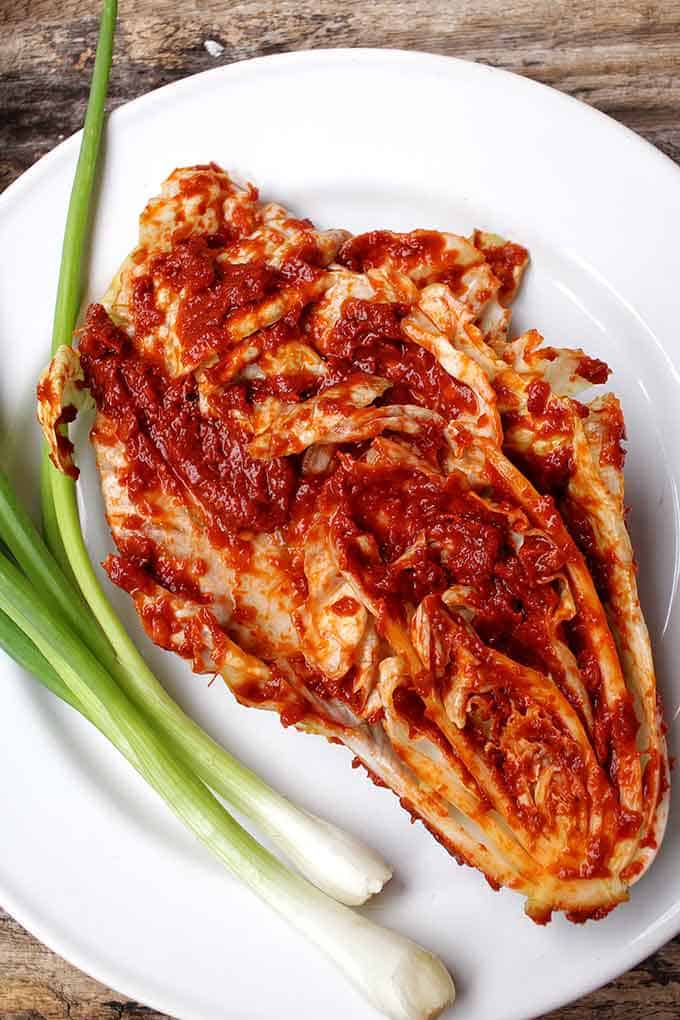
Traditional Square-Cut Napa Cabbage Kimchi
My love affair with gochugaru started when I learned to ferment traditional kimchi. The red pepper flakes combined with fish sauce and a variety of vegetables deliver not only a wide range of probiotics, but incredible flavors.
Due to fermented ingredients—like fish sauce—in many kimchi recipes, a single variety of kimchi might contain more than one hundred different types of microorganisms. And, a single gram of that fermented kimchi contains some 100 million lactic acid bacteria.
—From Cultured by Katherine Harmon Courage.
Korean Seasoning Sauce
This versatile condiment, dipping sauce, and marinade from the kitchn livens up everything from tofu to meat, vegetables, dumplings, and noodles. It calls for Korean red pepper flakes, soy sauce, sesame oil, rice vinegar, and a few other flavorful ingredients.
Red Pepper Kimchi Seasoning Paste
There are many recipes for kimchi—the spicy Korean vegetable side dish. But one thing that’s common through them all: the need for a spicy chili pepper paste.
This simple homemade kimchi paste by Pepper Scale is a terrific catch-all across kimchi recipes, but it can do more than that. Use it, too, as a way to spice up soups and stews. It has a delicious spicy-sweet flavor that works in many tomato-based soups.
Carrot Kimchi (Tanggun)
Shredded carrots are brined and flavored like kimchi. Enjoy on their own, in a salad, on a rice bowl, atop a taco, or whatever else you dream up.
Quick Cucumber and Chive Kimchi
On the Mother’s in Law’s website is this recipe for a quick salad that requires no fermentation.
French Breakfast Radish Kimchi
For those of you looking for a vegan option for fish sauce, a common substitution is mushroom broth as used in this recipe for French Breakfast Radish Kimchi.
Korean Lettuce Salad (Sangchu-geotjeori)
Sangchu-geotjeori is a bright, spicy, lightly seasoned lettuce salad that is meant to be made and eaten right away, not fermented like kimchi. The recipe is found on Maanghi’s Korean cooking website.
Gochujang Sauce
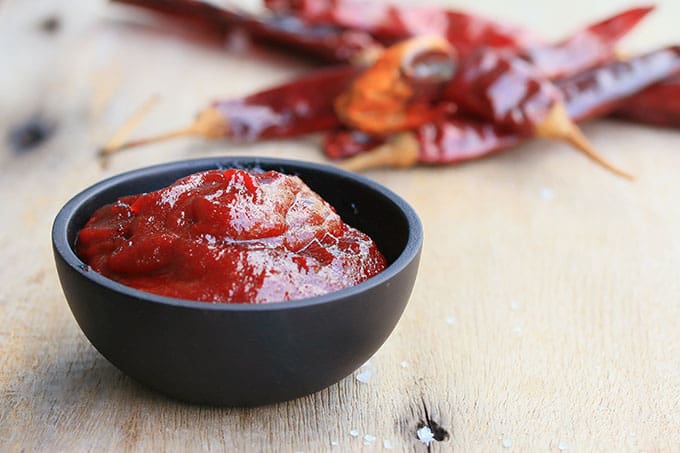
When looking for recipes for red pepper paste for kimchi making, you might come across gochujang, an umami-rich sauce with a similar look to the kimchi seasoning paste.
Gochujang is a popular Korean condiment, aka the ketchup of Korea! “Gochu” means chile and “Jang,” fermented. Its unique flavor comes from a traditional fermentation process mixing fermented soybeans, red chili pepper, rice flour, malt syrup, and salt and fermenting the mixture for months in a porous earthenware pot called an onggi.
Over at FermentWorks, Kirsten and Christopher Shockey—the authors of my favorite book, No products found. share a recipe for both traditional gochujang and quick gochujang.
Gochugara makes a great gift for a special friend who is into spicy foods—or not so spicy—and might want to try their hand at making kimchi. See more gift ideas in my fermentation gift guide.
Look for “Korean chili powder” or “gochugaru.” The powder should actually be coarse flakes, (not a fine powder) and made from sun-dried Korean red chili peppers. Look for “sun-dried” on the label.
Substitutes such as crushed red pepper, chipotle powder, cayenne, and jalapenos can all deliver some heat to your dish though none can impart the flavors that gochugaru can.
Your best bet is to combine 1 tablespoon paprika with 1 teaspoon chili powder to try to duplicate the color and heat found in gochugaru.
Gochugaru is the Korean equivalent of red pepper flakes. Gochu means chili pepper and garu means powder. Gochugaru is made from Korean chili peppers that have been sun dried and ground to flake size.
No. Gochujang is a popular Korean condiment, aka the ketchup of Korea! “Gochu” means chile and “Jang,” fermented.
Gochugaru are Korean red pepper flakes used to make kimchi.
Gochugaru is available both online and at Asian markets or upscale grocery stores.
For the best quality, select a brand that has been naturally sun-dried (you might see “taekyung” or “taeyangcho” on the label) and has only red pepper as an ingredient.
Look carefully at its texture to ensure you are purchasing the flakes and now powder.
Time to stock your pantry with Gochugaru, the secret ingredient that gives kimchi its signature heat, color, and flavor, and then ferment something delicious.
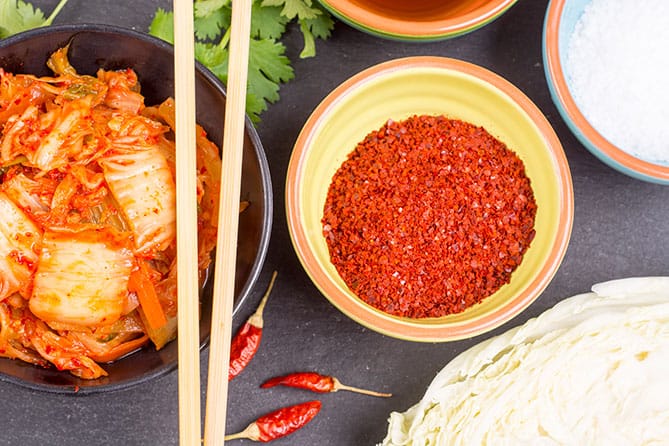
Last update on 2024-07-26 / Affiliate links / Images from Amazon Product Advertising API

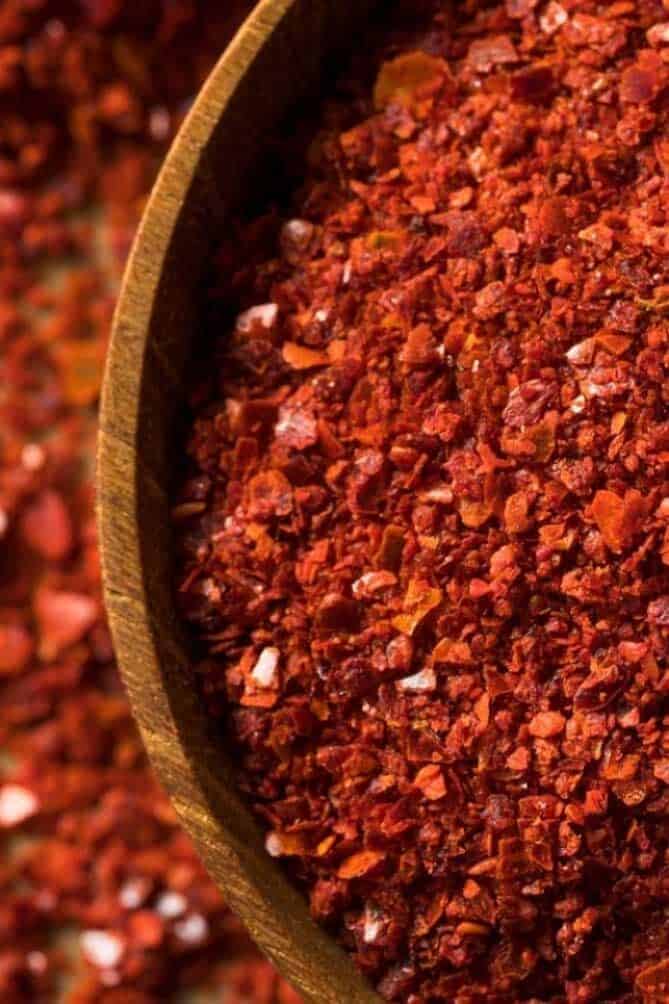

 This post may contain affiliate links which won’t change your price but will share some commission.
This post may contain affiliate links which won’t change your price but will share some commission.